
WhatsApp Message Template: A How-to Guide with 13 Examples
Businesses can't send WhatsApp messages after 24 hours unless they use WhatsApp Message Template. Learn how to format and send template messages plus examples.

When it comes to social media channels, TikTok and Instagram go toe to toe with each other. They both have global recognition, over 1 billion users each, similar engagement features and are highly addictive.
However, from a business perspective, they offer different opportunities based on each app's main features and functionalities. We’ll explore 9 key differences between TikTok vs Instagram to help you decide which to use for your business.
TikTok is a social media platform for creating, sharing and discovering short videos. You can create, share and watch short videos, that are minimally edited and trendy.
Features like Duet, Stories, For You Page, Stitch, Branded hashtags, in-app editing tools and filters attract and retain audience attention. Another key feature is TikTok Shop, which promotes seamless buying and selling on the platform.
Pros of Using TikTok for Businesses and Creators
TikTok is a highly engaging platform, especially among Gen Z, making it a great choice for brands targeting younger audiences. Its informal nature allows creators to post fun videos with minimal effort.
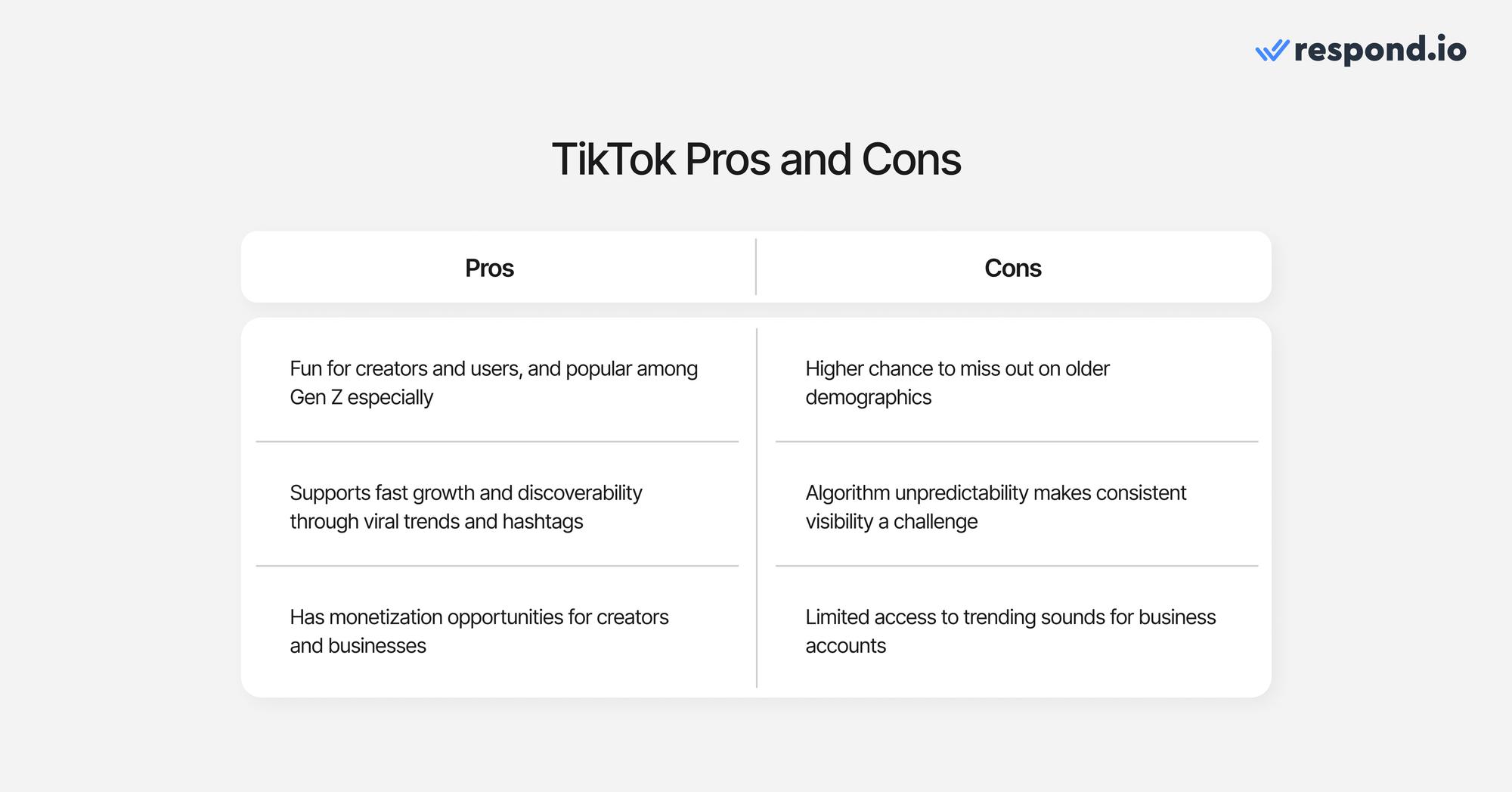
The platform also offers fast growth and discoverability. Viral trends and hashtags allow businesses, especially new ones, to gain traction quickly and build brand awareness. Additionally, TikTok provides various monetization opportunities through features like Live gifts, creator funds, TikTok ads, and TikTok Shop, offering businesses multiple ways to drive revenue.
Cons of Using TikTok for Businesses and Creators
While TikTok excels with younger audiences, its predominantly Gen Z user base may not align with every brand’s target market. Furthermore, businesses can’t use the general music library, though they can use the Commercial Music Library.
Moreover, TikTok’s unpredictable algorithm makes consistent visibility difficult to achieve. There’s no clear pattern of the video reaching audiences, adding uncertainty to marketing efforts.
Instagram is a media-driven social media platform that supports long and short videos, photos in various formats, live broadcasts and more.
Like TikTok, Instagram offers a variety of interactive features, including Reels, Stories, Instagram Live, IGTV and the Explore page. These features captivate users by encouraging relaxation and discovery, while businesses leverage Instagram's high engagement rates to showcase products and promote services.
Pros of Using Instagram for Businesses and Creators
Instagram excels as a platform for visual storytelling, offering various content formats like photos, videos, and reels. This flexibility allows businesses to creatively showcase their products or services while enabling creators to build and present their personal brands in unique ways.
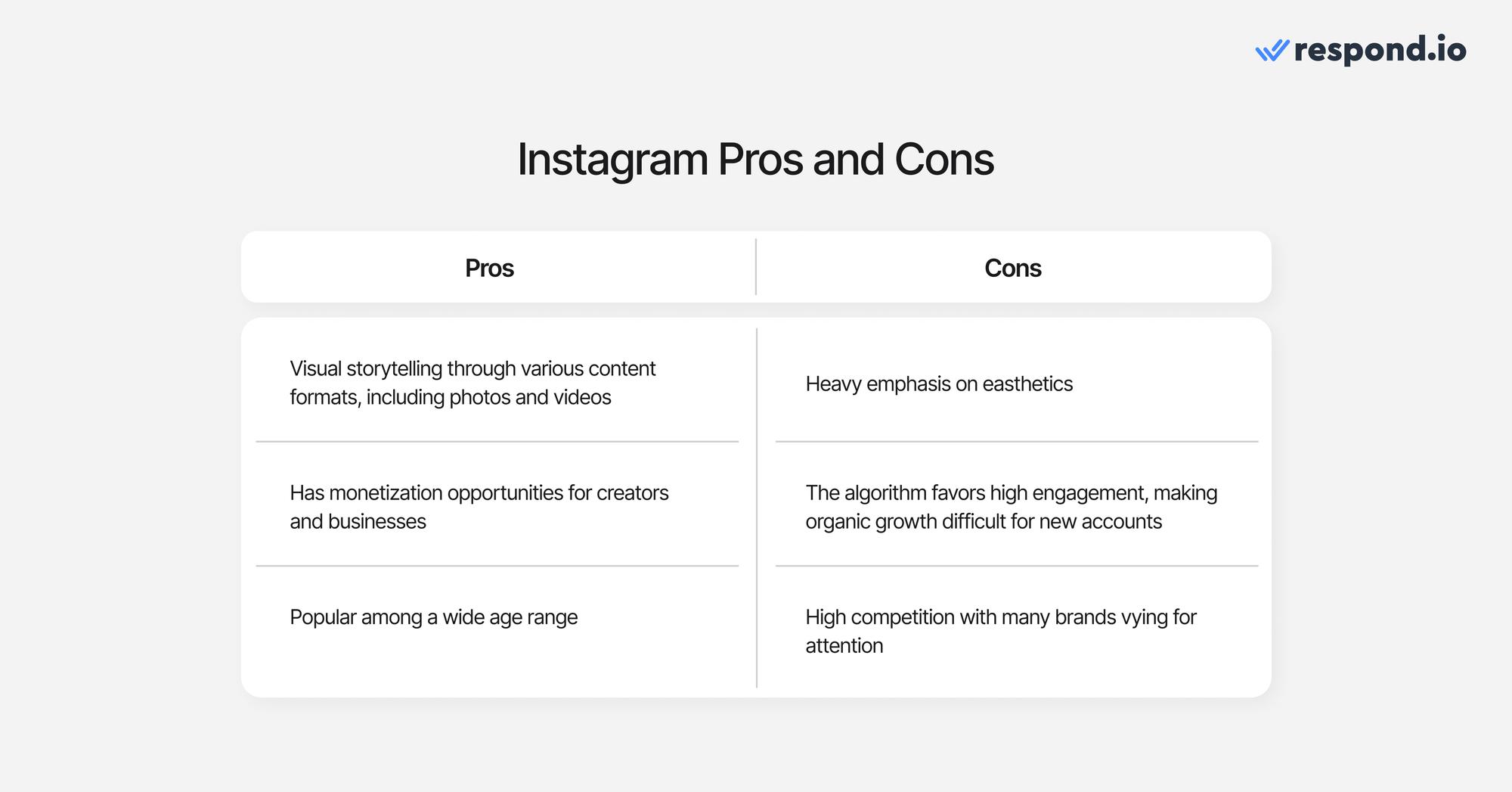
The platform also provides excellent monetization opportunities. Features like click-to-chat ads, the Instagram Shop, and shoppable posts help businesses turn engagement into sales.
For creators, brand partnerships, affiliate marketing, and tools like badges on IG Live make monetization accessible. Instagram’s wide appeal across age groups ensures both businesses and creators can reach a diverse audience.
Cons of Using Instagram for Businesses and Creators
However, there are challenges for both groups. The platform’s emphasis on aesthetics requires significant effort in producing visually appealing content to stand out. For creators, this means consistent branding, while businesses must maintain a professional look and feel.
Additionally, Instagram’s algorithm shows posts that have high engagement or posts from people you follow. This makes organic growth tougher for new businesses and emerging creators. With high competition across industries and niches, standing out demands continuous innovation and adaptability.
Turn customer conversations into business growth with respond.io. ✨
Manage calls, chats and emails in one place!
Though TikTok and Instagram are similar in some ways, they remain quite different.
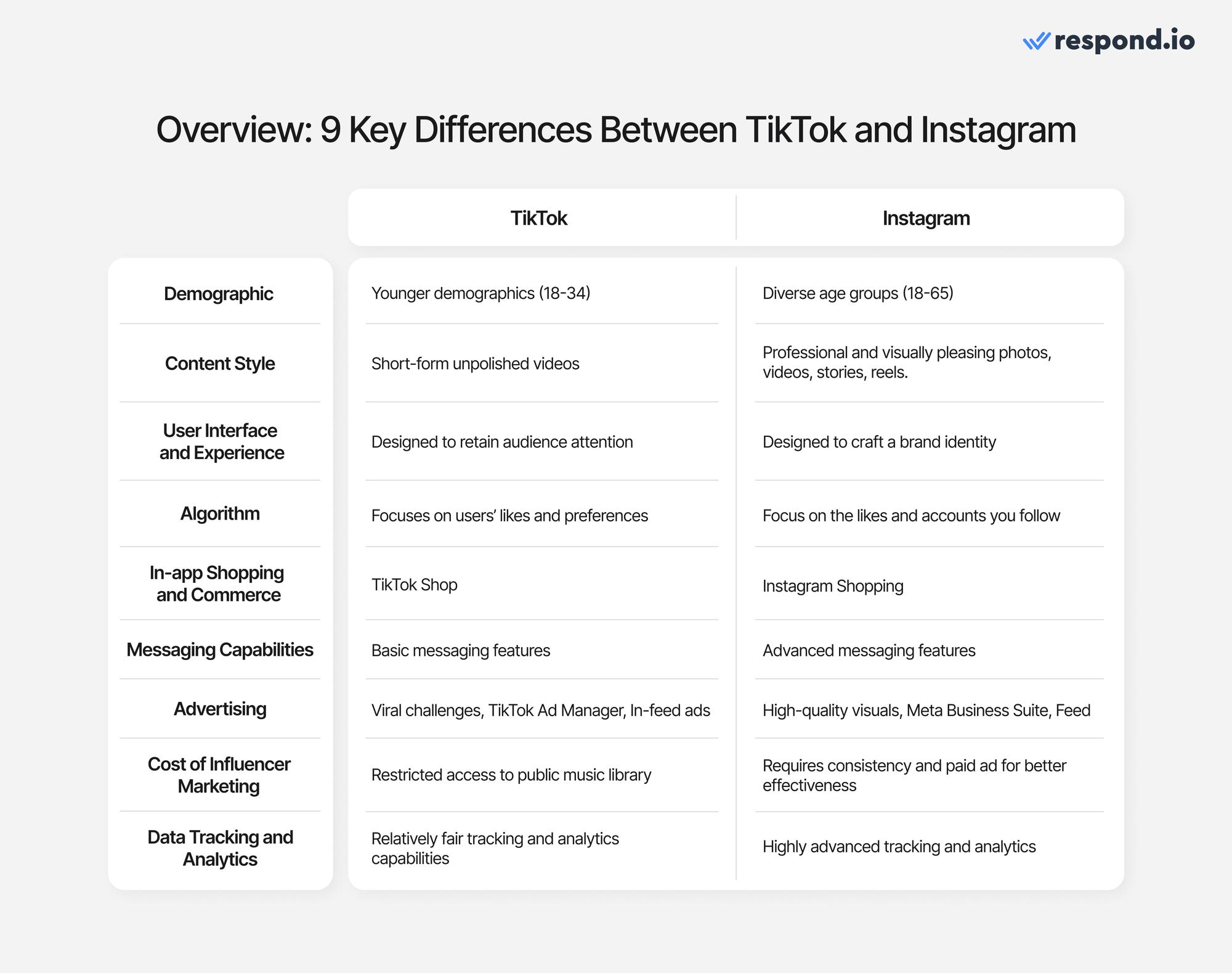
Let's compare these platforms.
TikTok focuses on short, authentic, and engaging videos, appealing primarily to younger audiences aged 18-34, including Gen Zs and younger Millennials. It has a significant global reach, particularly in Indonesia, the U.S., and Brazil, where users enjoy its trend-driven content.
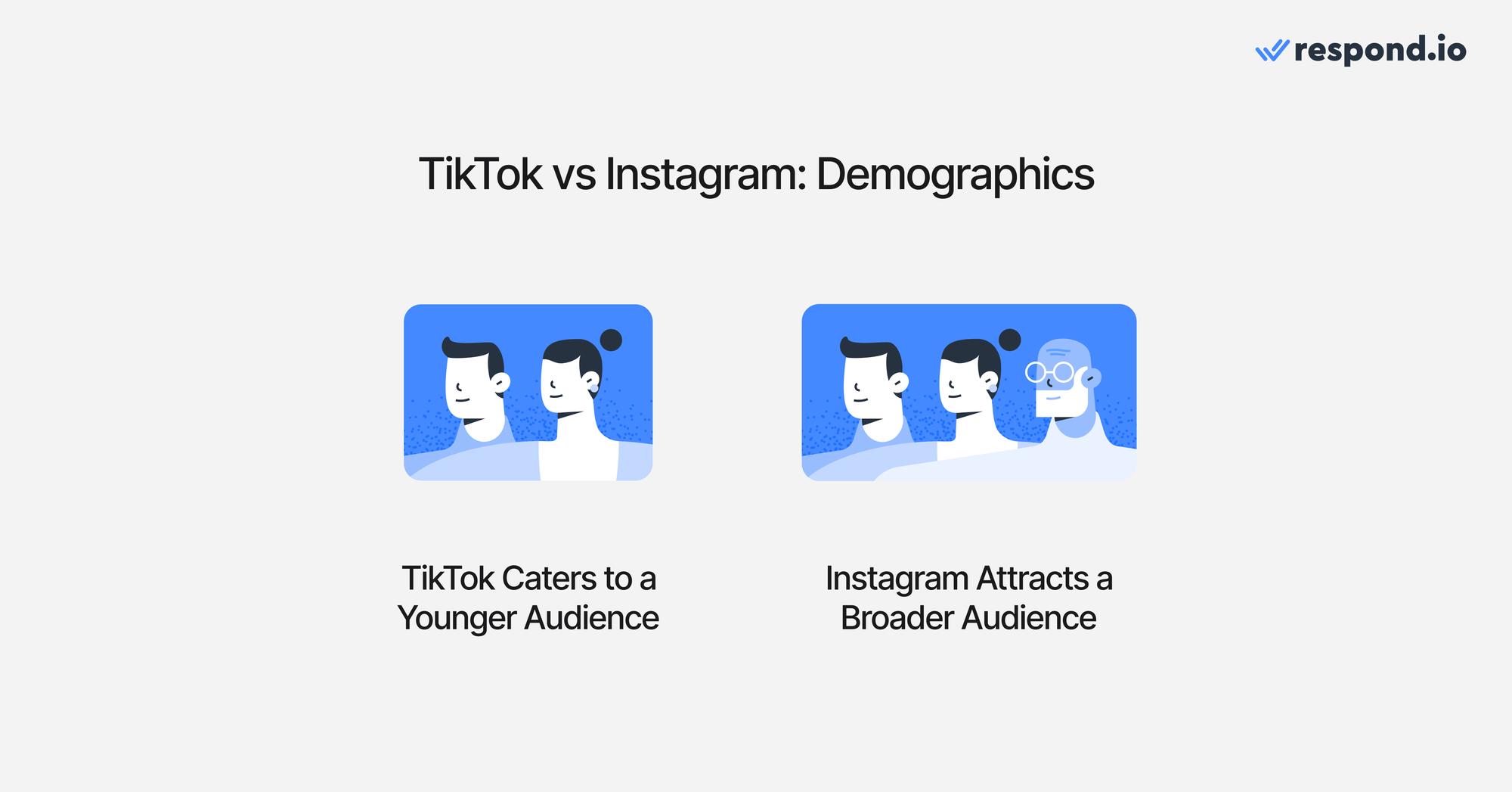
Instagram, with a broader demographic range of 18-65+, attracts Gen Zs, Millennials, and Gen X. Popular in India, the U.S., and Brazil, it is widely used worldwide and enjoys a nearly equal gender distribution.
For businesses, TikTok is ideal for targeting younger audiences with relatable content, while Instagram suits those aiming to reach a wider and more diverse user base.
Both platforms have similar features for businesses and content creators. However, they have different requirements or work differently. Let’s look at that next.
Reels
TikTok focuses on short videos ranging from 15 seconds to 3 minutes or more. In contrast, Instagram Reels are capped at 90 seconds, with longer uploads automatically trimmed. Unlike TikTok’s exclusive focus on videos, Instagram offers additional formats like Feed videos and IGTV.
Live Streaming
TikTok Live requires users to have at least 1,000 followers and be 18 or older (19 in South Korea) to host or send gifts. Features include multiple guests, Live Gifts, and video replays.
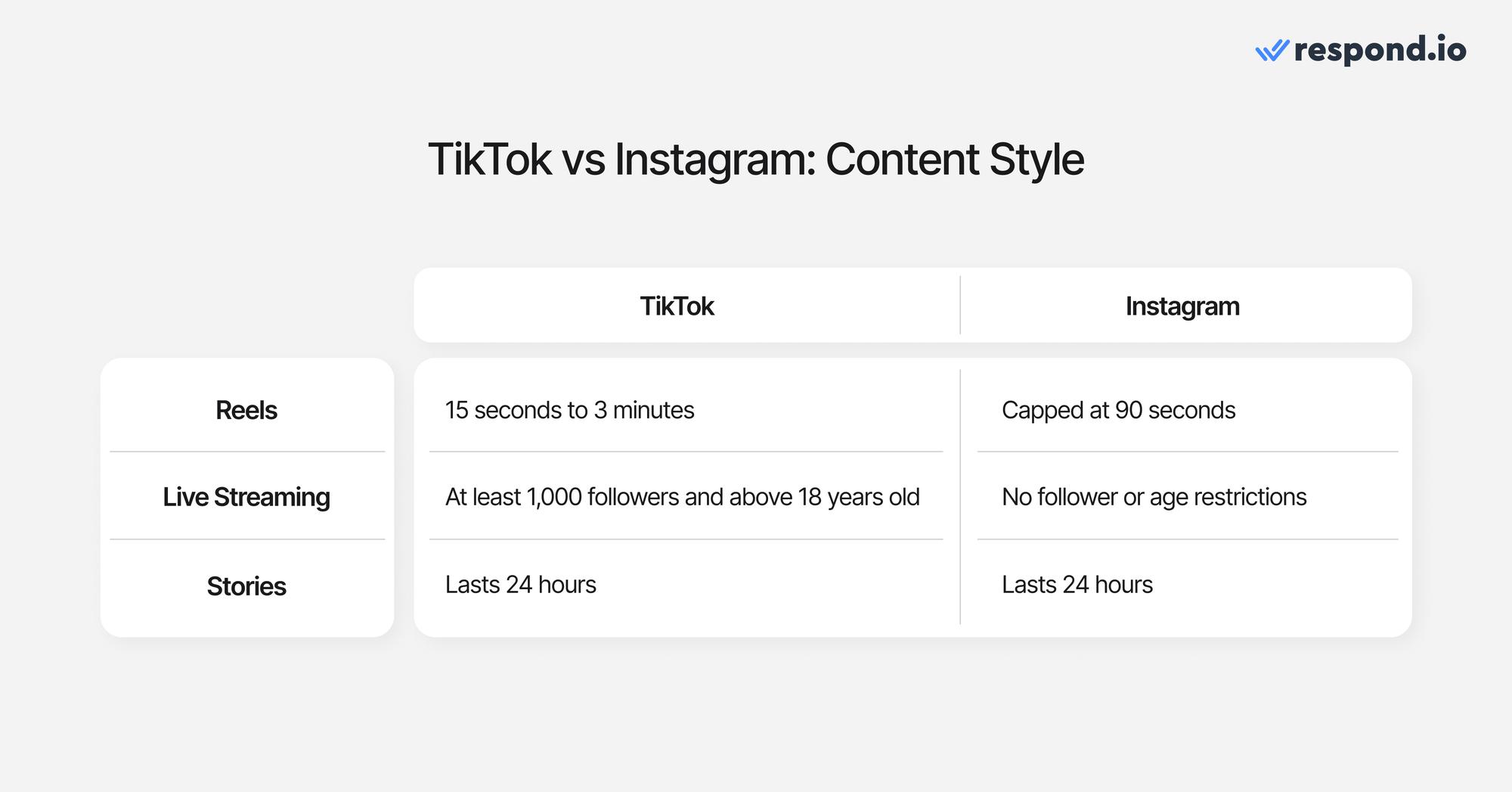
While Instagram Live has no follower or age restrictions, users still need to be at least 13 years old to access Instagram. Furthermore, sessions can be saved for later viewing, but comments and likes aren’t preserved. Both platforms enable real-time engagement for businesses.
Stories
TikTok Stories last 24 hours and can include text, images, or videos visible even on the “For You Page.” They behave like normal TikTok posts where you can’t pick and choose which Stories you want to see. They are all recommended.
Instagram Stories, also temporary, are only visible to followers, requiring a larger audience for impact. Unlike TikTok, followers must click on a Story to see it. This is an opportunity for businesses to run promotions to encourage follower growth and interaction with you.
TikTok’s immersive interface stands out with its full-screen vertical feed, ensuring content captures the viewer’s complete attention. Its Discover tab is tailored for trending content and creative discovery, making it easy for users to explore beyond their usual interests.
Features like duets and stitches allow businesses to foster direct audience interaction and co-creation. These tools, coupled with seamless built-in video editing, make TikTok a powerful platform for creating dynamic, customer-centric campaigns.
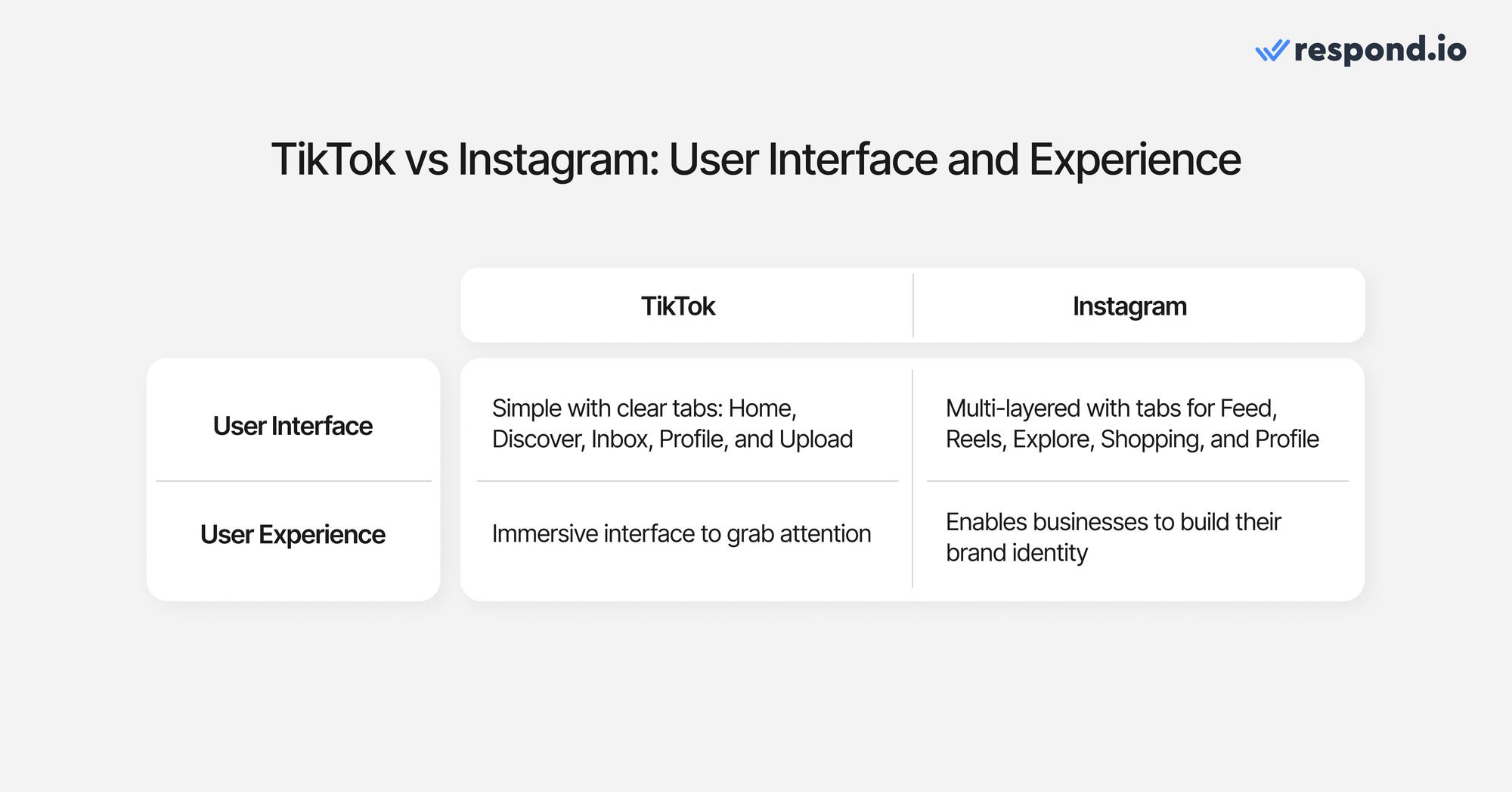
Instagram offers businesses a different experience with its grid layout, allowing brands to curate a polished, cohesive visual identity that remains visible on their profile. The Shopping tab is another unique element, seamlessly integrating e-commerce into the platform and offering businesses a direct pathway to sales.
Instagram’s multi-layered interface, with dedicated sections like Stories and Explore, provides more flexibility for long-form engagement and varied content formats, catering to businesses aiming to nurture deeper, multi-step interactions with their audience.
TikTok’s algorithm focuses on the interest of the user. It studies your likes and types of content you spend a longer time watching. When you open the app, the For You Page shows you content that matches your interests, regardless of who posted them. This is why it is much easier for content to go viral on TikTok, even if it was posted from a new account.
TikTok’s algorithm can favor businesses with less popularity and followers as long as they consistently share relevant and engaging content.
Instagram’s algorithm looks at both content and relationships first before anything else. It tends to show posts from accounts you follow or interact with often. However, it can also suggest posts based on interests.
Businesses that have built a reputation and a large following on the platform can count on the Instagram algorithm to work in their favor.
TikTok ranks as the top platform for impulsive buying in 2022. It’s ideal for targeting impulsive buyers through captivating videos that direct users to your inbox or TikTok Shop, an in-app store that streamlines the shopping experience.
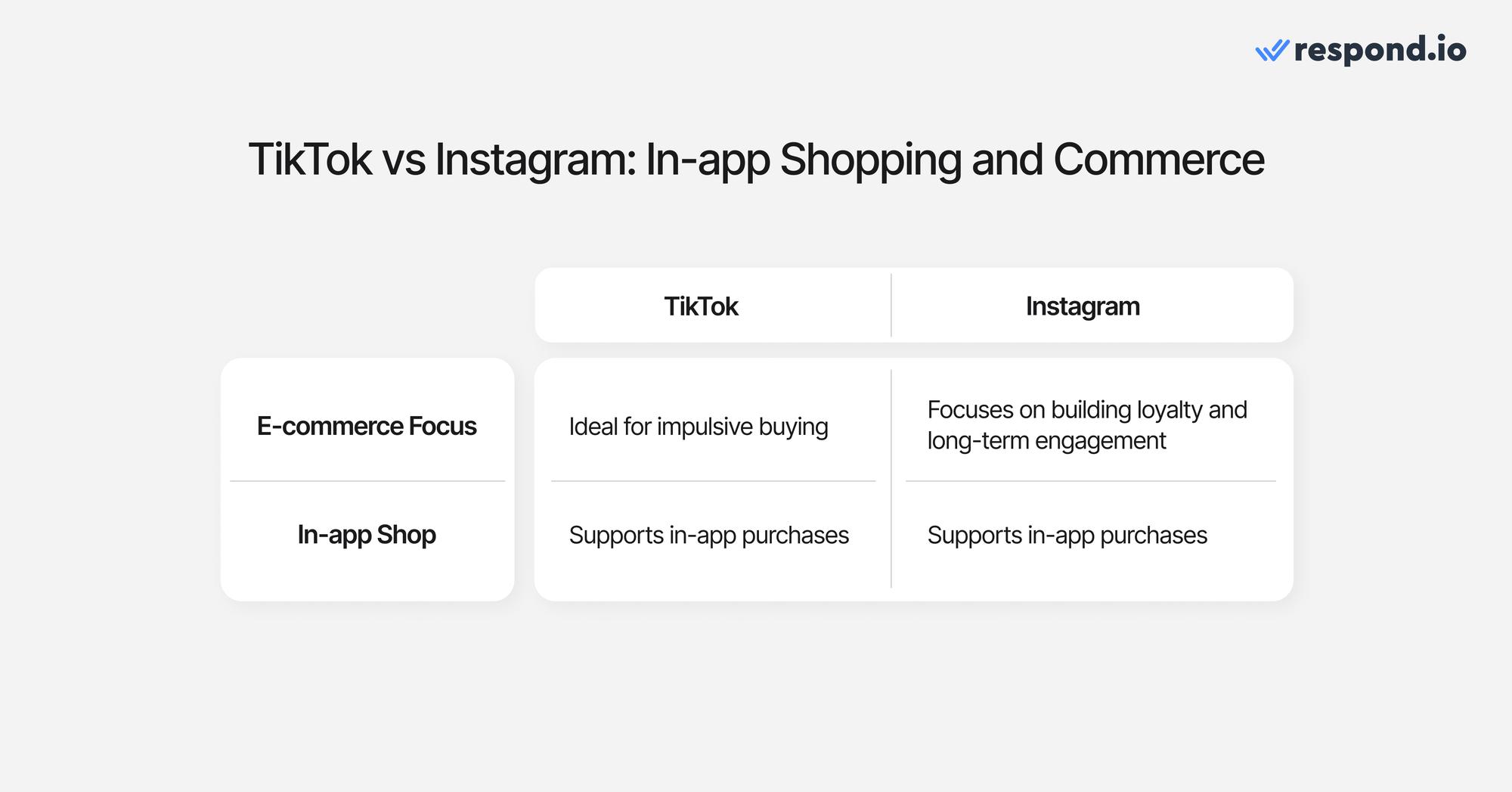
Instagram, with its established e-commerce presence, offers a more structured approach, appealing to a broader demographic. Its mix of photo and video content, advanced messaging, and tools like Instagram Shopping make it excellent for community-building and nurturing return customers.
While both platforms support in-app purchases, Instagram is especially good at helping brands build loyalty through long-term engagement.
To use TikTok’s direct messages (DMs), both need users to follow each other first. Furthermore, users must be above 16 years old to access this feature. Users can share emojis, stickers, links, and, in some regions, photos and videos. Group chats are limited to 32 participants, only available in select countries, and require mutual following for participation.
In contrast, Instagram offers advanced messaging features, allowing messages to be sent to both followers and non-followers. It supports group chats with up to 250 members and includes options like emoji reactions and vanishing messages.
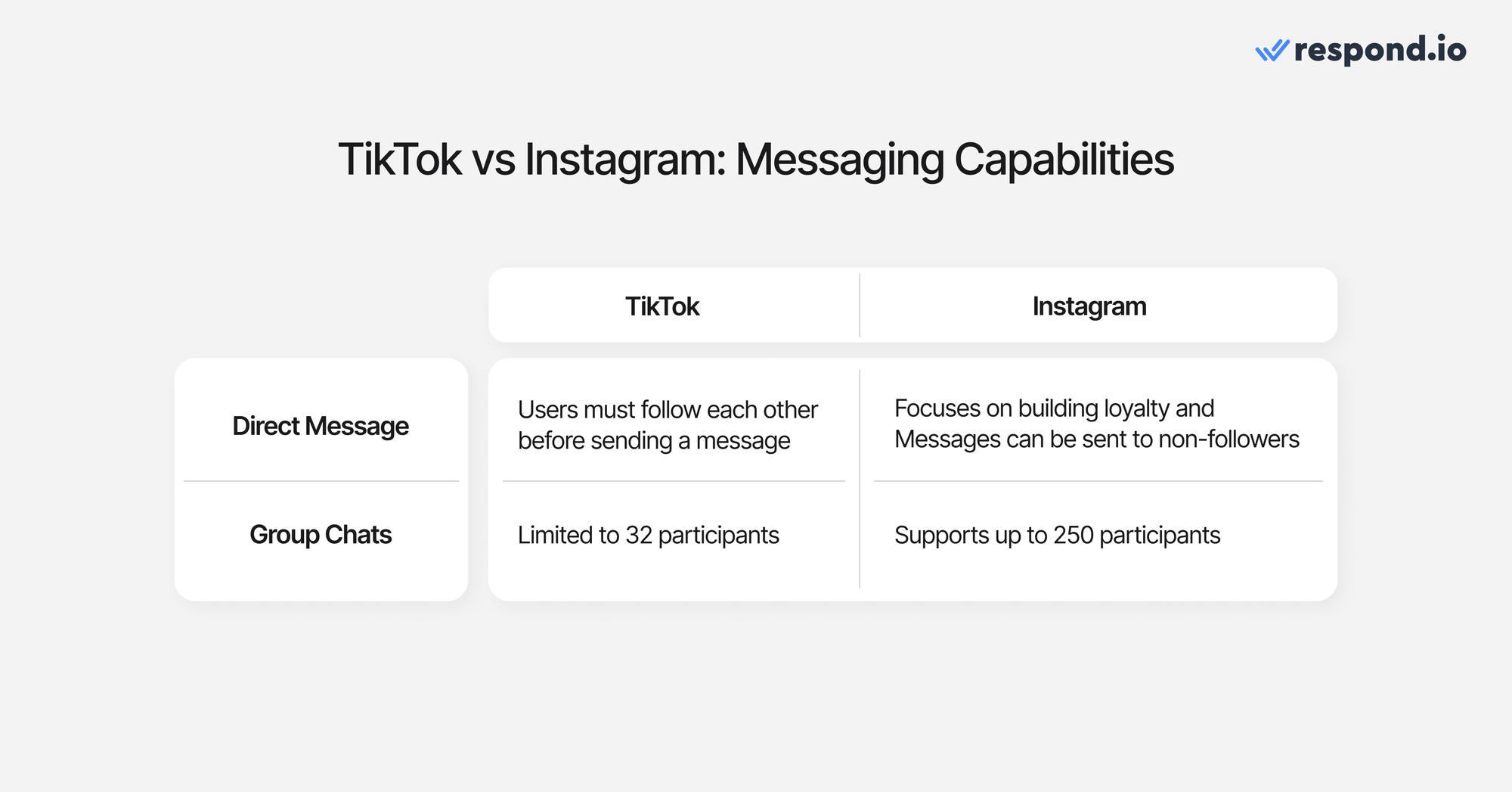
If you want to message at scale, then you’ll need a customer conversation management software like respond.io to unlock additional messaging capabilities. You can integrate both TikTok and Instagram DMs in respond.io.
There are many types of TikTok ad formats, including in-feed, TopView and branded hashtags. If you depend on messaging for sales and marketing, then you should consider using TikTok Messaging Ads, a type of in-feed ad. When a user clicks on this ad, it sends them to your TikTok DM or an external messaging app like WhatsApp or Messenger.
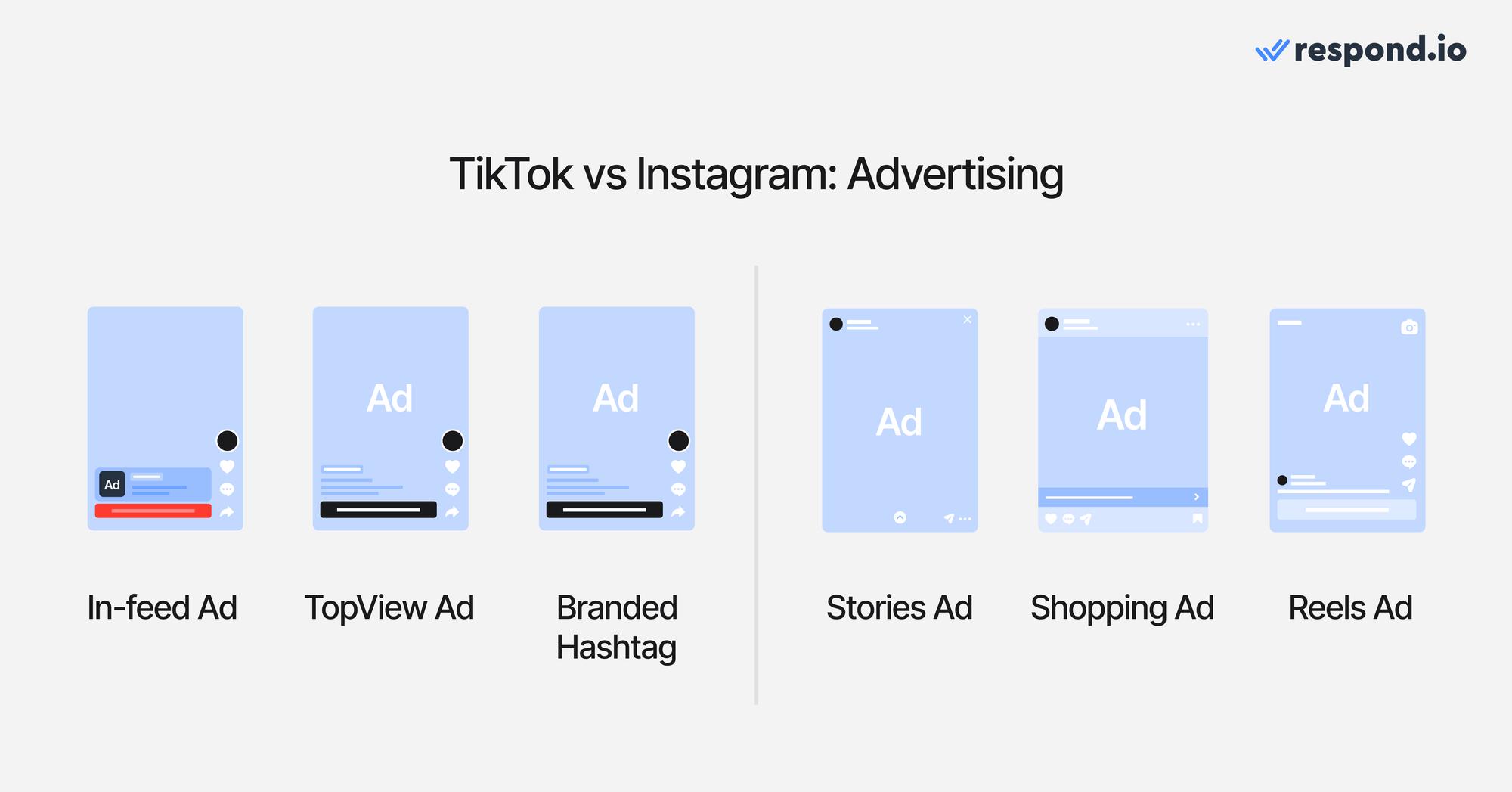
Instagram ads give you more creative freedom in terms of content type. You can create photo, video and carousel ads and choose any placement of your choice, such as Feeds, Stories and Explore page. Keep in mind that your ad placement will determine the timing and ratio length of your content.
Furthermore, since Instagram is a part of the Meta family, you can use the Meta Ad manager to set up ads that will run on Instagram and Facebook, giving your ad better visibility on other channels.
TikTok and Instagram are both great platforms to pursue influencer marketing. However, the cost to hire an influencer greatly differs between them. Instagram influencers tend to be more expensive.
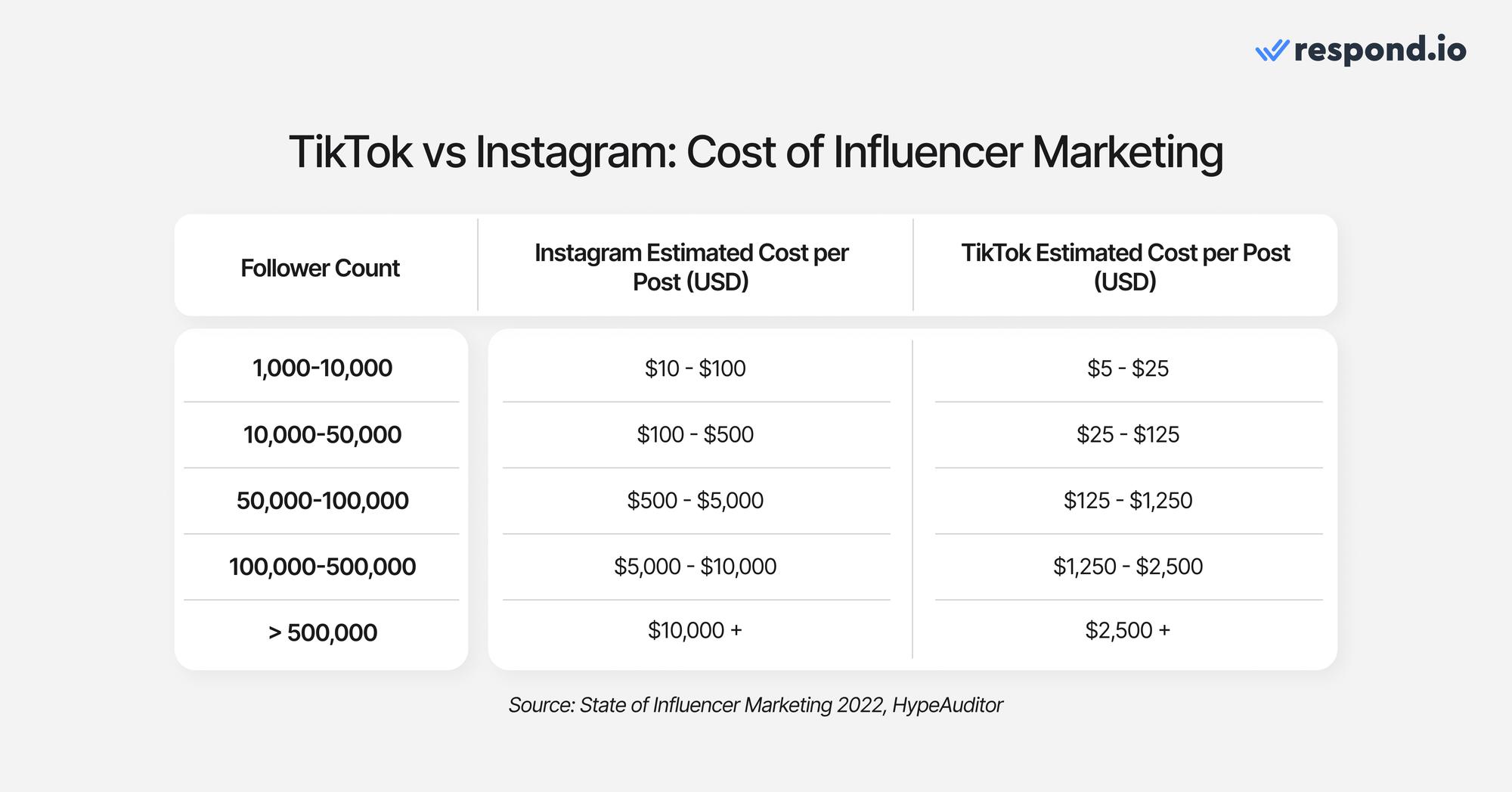
This could be due to Instagram’s older, more affluent demographic. This means that there are more Instagram users who have more disposable income to spend on products sold on Instagram compared to TikTok.
Both platforms track key metrics like impressions (views), likes, comments, click-through rate, shares and more. This tool helps you understand your business performance and make strategic decisions.
Keep in mind that using a personal account on both platforms only provides limited data insight. So, make sure you’re using a creator or a business account to get more insights.
Now that you know the differences between the platforms, let’s take a look at the businesses that won big with both platforms
Both platforms have real-world benefits where businesses have already won big. Here are just two businesses that have tremendous success with TikTok and Instagram
Crumbl’s is a fast-growing cookie retail chain. In just 2024, it added 294 new stores. This explosive growth in recent years is due to its viral marketing campaigns on TikTok and Instagram.
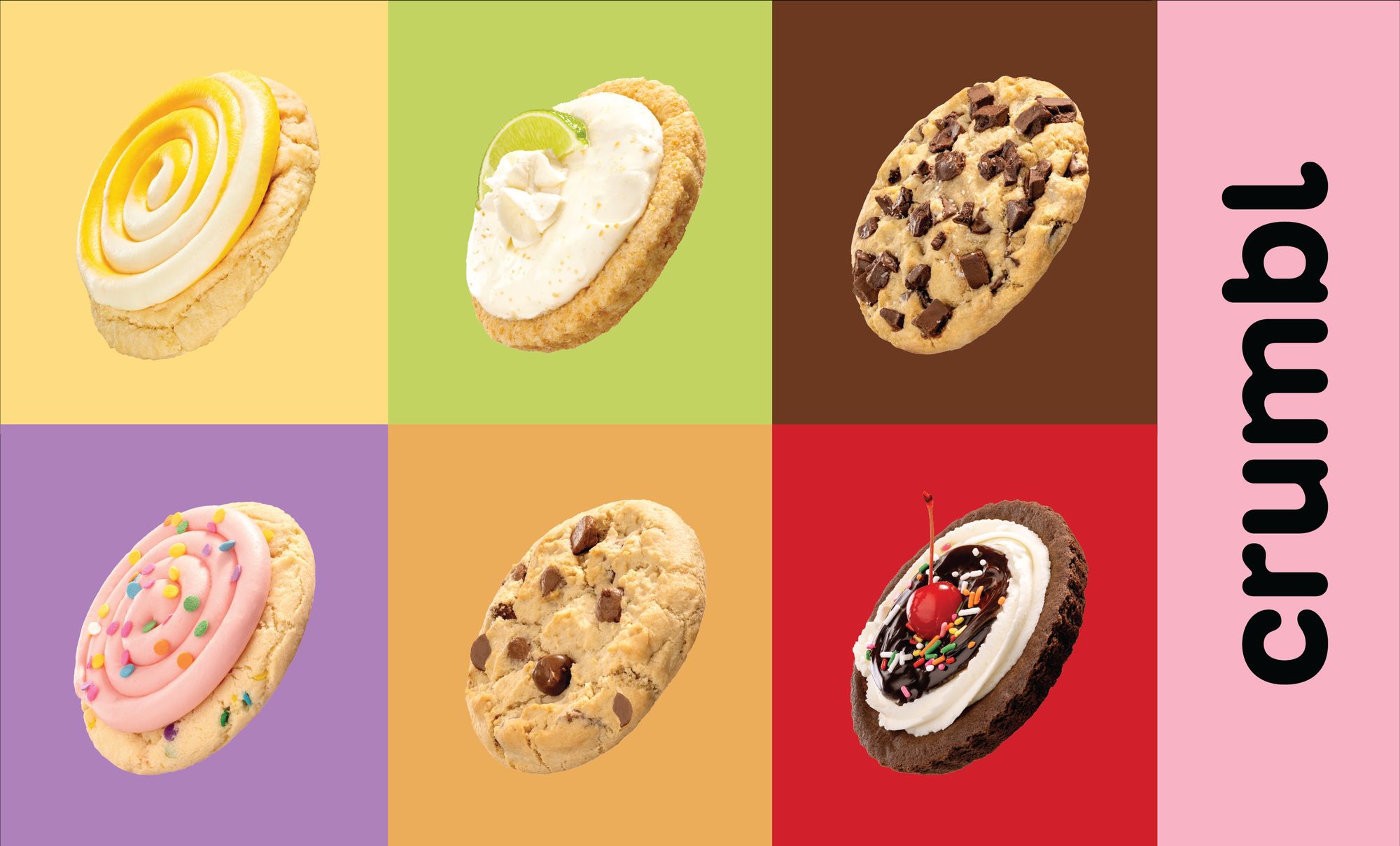
On TikTok alone, their use of Sparks Ads increased their follower count by 1,500%!
Savage X Fenty, the inclusive lingerie brand co-founded by Rihanna, wanted to increase brand awareness and reach new audiences on Instagram. To achieve this, they supplemented their direct response advertising with reach-optimized, brand-focused campaigns.
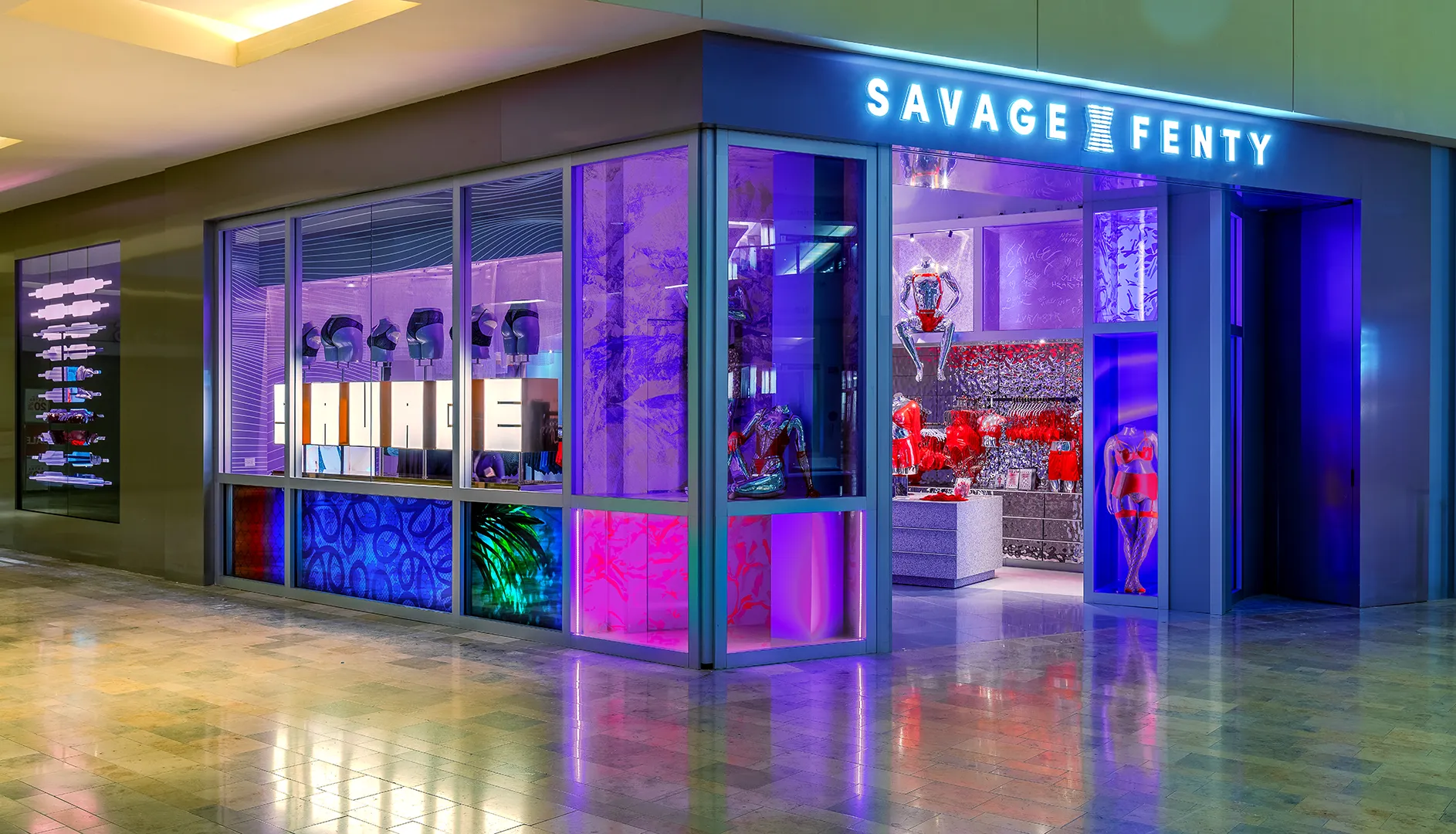
By the end of the campaign, it increased purchase intent by 5.3 points, customer reach by 50% and decreased cost per thousand impressions by 28%.
Lastly, let’s look at which platform is best for your business, especially when it comes to increasing revenue.
Now that you’re familiar with the features, differences and business successes on both platforms, which should you choose? In this section, we’ll look at how both platforms compare.
The first thing to keep in mind if you want to use TikTok for lead generation and sales is the demographic, especially in terms of age. You need to make sure your target audience uses the app. That way, you have a better chance of achieving your goals.
The next thing is the type of content prevalent on the platform. Be ready to jump on trends, create fun videos as often as possible, come up with challenges and stay highly active on the app. And feel free to mention what you offer at any given opportunity.
Also, TikTok’s algorithm can work in your favor if you post relevant videos. Plus you can partner with creators and influencers in your niche to reach more people. However, all these only work towards getting you leads, converting them to paying customers should be the focus.
You can leverage Instagram to find new customers and drive sales in your business. Since it is more of a visual platform, it would make sense for you to post professional photos and videos of your products.
If you can’t afford a professional shoot, just make sure the content you post is clear, coordinated and easy to understand. Since Instagram has a wide range of users in terms of age and versatile features, it gives a better chance of reaching more people.
However, you must be ready to put on your thinking cap to create unique content that will catch the eye of your target audience. Features like Stories, Reels, Explore pages, Live sessions, Broadcast channels, group chats and so on can help you form a more personal connection with your potential customers, which can lead to higher engagement.
TikTok is an excellent platform for reaching younger, trend-driven audiences, making it ideal for businesses targeting Gen Z and Millennials. Its algorithm and vibrant creator community offer significant potential for organic reach and lead generation.
Instagram, on the other hand, offers a more versatile platform with a wider demographic reach and features designed for visual storytelling. It’s particularly effective for showcasing products professionally and building deeper connections through interactive tools like Stories, Reels, and Live sessions.
Both platforms are great channels to attract more leads and customers. Using either one or both platforms depends on your brand tone and voice, target audience and business goals.
While both TikTok and Instagram offer business tools, their effectiveness depends on how well you can manage customer conversations. Instagram is a well-established platform for sales and engagement, but TikTok’s rapid growth presents a unique opportunity to connect with a younger, highly engaged audience.
Businesses that sell through chat across multiple channels need more than just basic tools—they require advanced automation, analytics, security, and seamless communication. As a trusted TikTok partner, respond.io provides the features necessary to optimize lead conversion and customer interactions on both platforms.
Engaging with potential customers on TikTok can be challenging without the right tools. While Instagram Direct Messaging is widely used, TikTok Business Messaging offers a fresh opportunity to connect with users in a more interactive and dynamic way.
Respond.io’s integration with TikTok Business Messaging helps businesses streamline conversations, manage inquiries from organic posts and ads, and maximize conversion potential—all from a single platform that also supports Instagram, WhatsApp, and more.
By leveraging TikTok Business Messaging alongside Instagram, businesses can create a powerful omnichannel strategy to engage audiences where they are most active. Currently in Beta and available in most regions except the U.S., EEA, Switzerland, and the U.K.,
TikTok Business Messaging allows businesses to centralize and automate customer interactions. If you have an eligible TikTok Business Account, connect it to respond.io today and start turning engagement into sales!
🚀 Big News! TikTok Instant Messaging Ads are now globally available! Now, businesses can connect with TikTok leads on WhatsApp and Messenger to offer consultations, schedule appointments, and close sales—all in a single conversation.
🔥 Exclusive Offer: Get 50% off TikTok Instant Messaging Ads spending when you integrate with respond.io and optimize your campaigns for conversations.
Turn customer conversations into business growth with respond.io. ✨
Manage calls, chats and emails in one place!
TikTok is all about short, creative videos, while Instagram is a mix of photos, videos and Stories.
If you’re a startup, using TikTok is better, as you can leverage viral trends to spread awareness of your brand. Alternatively, you can create awareness or sales campaigns on both platforms to drive growth.
Yes, you can! Many people and businesses use both.
Benjamin Steve Richard joined respond.io as a Content Writer in 2023. Holding a Bachelor of Laws degree from the University of London, Benjamin provides invaluable resources on messaging apps for businesses to help them leverage customer conversations successfully.

Businesses can't send WhatsApp messages after 24 hours unless they use WhatsApp Message Template. Learn how to format and send template messages plus examples.